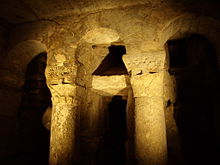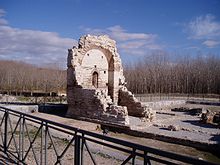

This article relies largely or entirely on a single source. Relevant discussion may be found on the talk page. Please help improve this articlebyintroducing citations to additional sources.
Find sources: "Visigothic art and architecture" – news · newspapers · books · scholar · JSTOR (April 2020) |




The Visigoths entered Hispania (modern Spain and Portugal) in 415 and they rose to be the dominant people there until the Umayyad conquest of Hispania of 711 brought their kingdom to an end.
This period in Iberian art is dominated by their style. Visigothic art is generally considered in the English-speaking world to be a strain of Migration art, while the Portuguese- and Spanish-speaking worlds generally classify it as Pre-Romanesque.
Branches of Visigothic art include their architecture, crafts (especially jewellery), and their script.
The only remaining examples of Visigothic architecture from the 6th century are the church of San Cugat del VallésinBarcelona, the hermitage and church of Santa Maria de Lara in Burgos, Saint Frutuoso ChapelinBraga, the church of São GiãoinNazaré and the few remnants of the church at Cabeza de GriegoinCuenca. However, their style developed over the next centuries, though the prime remaining examples of it are mostly rural and often run-down. Some of the characteristics of their architecture are:
Examples include: